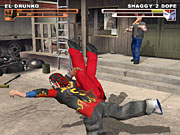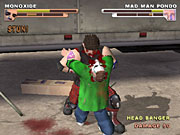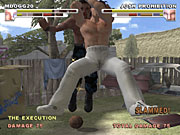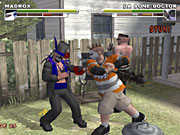Backyard Wrestling Designer Diary
Lead designer Kevin Gill and producer Edwin Denicholas touch on the making of Eidos and Paradox's upcoming brawler.
Kevin Gill
Lead Designer/Eidos Interactive
Why Backyard Wrestling?

Backyard Wrestling was chosen because it's a multicultural, multinational, home video, DVD, and pay-per-view juggernaut around the world. It has successfully captured the imaginations of wrestling fans and casual video game players from around the world. Backyard Wrestling delivers the "Holy S***" factor of pro wrestling, complete with over-the-top stunts, flamboyant characters, and unique combat environments, all driven by a killer 41 song soundtrack. Timing also played a big part though. This isn't a few years back--when the ECW, WCW, and WWF were thriving and drawing turn-away crowds. Take a look at the wrestling business in America today. The pro wrestling industry in America is now a monopoly, controlled by a former billionaire who's desperately trying to recapture his glory days. He's completely alienating his core fans, and he's always shoving his untalented family down everyone's throats. Meanwhile, people are tuning out in droves. When we had the chance to team up with the visionaries at Backyard Wrestling ("BYW"), who are responsible for shaking up the genre and giving the industry a kick in the pants, we jumped at it.
We were drawn to the license and style of BYW because of the unprecedented freedom it offered in terms of environmental interaction and gameplay. While most video game genres continue to evolve and innovate, from gameplay and design perspectives, the developers of wrestling games have essentially been churning out the same game for many years. The games really do lack true innovation. A huge reason for this is because the developers of wrestling games are forced to re-create a television show and are unable to use their imaginations to make the genre better. We saw Backyard Wrestling as something that completely captured the "magic" of pro wrestling and offered a huge crossover appeal to the casual gamer. We look at it as "all killer, no filler." We give the player the complete freedom to explore and destroy the environment, while allowing the sickest moves imaginable. We let players pick up and use countless weapons, and they inflict real-time damage to their opponents. Additionally, all the action is set against an imaginative environmental backdrop.

The challenges revolved around the fact that a game like this has truly never been made before. You've always been confined to a ring and forced to adhere to rules. To give players the complete freedom to explore and use the environment any way they want took a lot of time to conceive and design. The first thing we did was sit down and brainstorm about the environments you could fight in, the weapons you could use, how you would be able to use the weapons, and, of course, the characters you could control/play. The engine and the tools that were used had to be revamped from a one-on-one fighting game to make the environment interactive. All the basic systems, but especially the camera, had to be worked on extensively to support the "go anywhere" gameplay. We experimented with a lot of control types, seeing what worked best. The overly complicated system of meters and extensive button combinations didn't feel right, so we opted for a more pick-up-and-play style. The damage system was also a real challenge, as we wanted it to offer various degrees of damage that could occur on different parts of the body. It took a lot of work to get right--and more importantly--it took a lot of work to get it balanced. When you consider that most of this stuff came from our imaginations, you realize that there was no groundbreaking game we were trying to emulate. We were trying to break new ground ourselves.
Edwin Denicholas
Producer/Paradox Development
Multiplatform development

Design issues Throughout the BYW project, our primary development platform was the Sony PlayStation 2. Although developing for the PS2 is an excellent way to limit development, as the software will run on all other platforms with similar results, dedicated resources are still required for each additional platform to modify and extend the base product. Extensions can include a better rendering system, higher quality textures, additional user interface enhancements, and other improvements--so that the final product is indicative of each platform's strengths while decreasing the impact of any single platform's weaknesses.
Unfortunately, during the BYW project, we did not have this sort of support for the porting of Sony PlayStation 2 code to the Microsoft Xbox platform.
What we did have were two great programmers, and, from time to time, the help of an artist or designer who really took it upon himself or herself to make the best out of a bad situation.
With an additional, dedicated asset resource or two, we could have improved the look and feel of BYW, on the Xbox, to a greater extent. Simply porting code is not enough. A conscious and sustained effort must be made to find where improvements to graphical and asset quality can be made--in order to best take advantage of the strengths that the target platform may afford over the primary development platform.
Despite these hurdles, and due, in no small part, to the efforts of our talented programmers, I believe we managed to put out an excellent product which can be enjoyed on either platform with the same results.
The Search for Platform Independence Platform independence is perhaps the holy grail of software development. To achieve this goal requires a constant effort, on the part of all coders, to use interfaces that are common to both platforms.
This was not always the case during the development of BYW. Quite frequently, modifications done to platform independent code--by a coder using only a PlayStation 2 development kit or a coder using only a Microsoft Xbox development kit--would break one of the opposing codebases.

A constant and focused effort must be made to ensure that platform independent code remains platform independent. This requires a resource who's task is to ensure that code works on both platforms--after each major code revision. This resource does not necessarily need be dedicated to this task, as only major code revisions need to be addressed. Or perhaps only revisions at specific intervals need to be addressed.
The Test Cycle The third area in which cross platform development was lacking, during the BYW project, was in testing. We found that the Sony PlayStation 2 platform received the majority of our focus during the testing cycle. A proper test cycle should be conducted for each platform at each milestone delivered. However, it was common for us to find that Microsoft Xbox testing was relegated to a lower priority, as opposed to the PS2. This was clearly evident as the total number of bugs reported near the end of the PS2 test cycle was around one thousand, while the total number of bugs reported for the Xbox was around four hundred.
Therefore, dedicated resources must also be assigned to testing each intended platform. An entire test department, assigned to test one specific build, for one platform only, on a two platform project, will never catch more than 50 percent of all the possible bugs.
Got a news tip or want to contact us directly? Email news@gamespot.com
Join the conversation